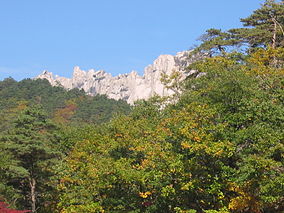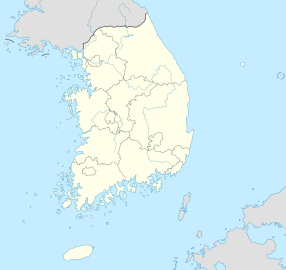- Seoraksan National Park
-
설악산국립공원, 雪嶽山國立公園 Seoraksan National Park IUCN Category II (National Park)
Location South Korea Coordinates 38°07′30″N 128°24′58″E / 38.125°N 128.416°ECoordinates: 38°07′30″N 128°24′58″E / 38.125°N 128.416°E[1] Area 398.22 km2 (153.75 sq mi) Established 24 March 1970 Governing body Korea National Parks Service Seoraksan National Park Hangul 설악산천연보호구역 Hanja 雪嶽山天然保護區域 Revised Romanization Seoraksan Cheonyeon Boho Guyeok McCune–Reischauer Sŏraksan Ch'ŏnyŏn Poho Kuyŏk Seoraksan National Park (Korean: 설악산국립공원, 雪嶽山國立公園) is a listed by the South Korean government with UNESCO as a tentative World Heritage site. The Korean government designated the area as a nature reserve in 1965 and UNESCO designated the area as a biosphere reserve in 1982. It was also the first Korean national park to be designated under the National Park Law in 1970. Located on the east and center of the Korean peninsula, the reserve covers Injegun, Yanyanggun, and Sokchosi. It is one of the most popular attractions for tourists and nature enthusiasts in Korea. The Soraksan Nature Reserve is valuable for its stunning natural beauty and rare flora and fauna.
The nature reserve protects an area of 163.6 square kilometers and contains many notable high peaks measuring over 1,200 meters above sea level including the highest peak of Soraksan, Daecheongbong, which has an altitude of 1,708 meters. The nature reserve contains mountain ranges of dissected granite and gneiss and is characterized by spectacular rocky hills and ridges. The magnificent natural beauty of Soraksan and the mountain ridges is due to these geographical features. Annual precipitation in Inner Soraksan is 1000 millimeters and 1300 millimeters in Outer Soraksan.[2]
Soraksan Nature Reserve region is known for the diversity of its flora. There are more than 822 vascular plant species classified in the region and a total of 1,013 species of plants. Pine trees are abundant on the southern slope while the northern slopes of the mountain range are characterized by Oak trees and other deciduous trees. Other trees include the Thuja trees which grow in the deep valleys and Siberian pine and native Korean Hanabusaya trees which grow on the ridges and high altitudes. Dwarf pines, forsythia, saussurea, and yew trees grow from the foot of the mountain and up. Juniper, hawthorn, and Korean edelweiss also grow in the reserve. Rare plants protected in the reserve include the Hanabusaya Asiatic and Abios nephrolepis.
1,562 animal species have been classified so far. Some notable animals include Asiatic black bears, musk deers, gorals, otters, Pteromys volans, Falco tinnuculus, Chinese sparrow hawks, Brachymystax lenoks, and Hemibarbus mylodon. In particular, endangered species such as the Dryocopos javensis richardsi, Naemorheudus goral raddeanus, and Moschus moschiferus parvipes are considered to be of major conservation significance. In addition to the plants and animals, biologically important and rare fish such as Brachmystax lenok and Moroco oxycephalus which are also protected and preserved.
The reserve is famous not only for its beautiful landscapes but for valuable cultural properties as well including Baekdamsa and Sinheungsa, Buddhist temples in the reserve. SorakSan snows every year when its in the winter, tempature goes under -30, which is very cold.
References
- ^ Seoraksan National Park protectedplanet.net
- ^ Cultural Heritage Administration of Korea (Korean)
See also
External links
World Heritage Sites in South Korea World Heritage Sites Changdeokgung Palace Complex · Gochang, Hwasun and Ganghwa Dolmen Sites · Gyeongju Historic Areas · Haeinsa Temple Janggyeong Panjeon, the Depositories for the Tripitaka Koreana Woodblocks · Historic Villages of Korea: Hahoe and Yangdong · Hwaseong Fortress · Jeju Volcanic Island and Lava Tubes · Jongmyo Shrine · Royal Tombs of the Joseon Dynasty · Seokguram Grotto and Bulguksa Temple
Tentative Lists Ancient Mountain Fortresses in Central Korea · Daegokcheon Stream Petroglyphs · Gangjingun Kiln Sites · Gongju and Buyeo Historic Sites · Iksan Historic Areas · Mt. Soraksan Nature Reserve · Naganeupseong, Town Fortress and Village · Namhansanseong - Ancient Fortified Military and Cultural Landscape of Mt. Namhansan · Oeam Village · Salterns · Sites of fossilized dinosaurs across the southern South Korean coast · Southwestern Coast Tidal Flats · Upo wetlandNational parks of South Korea Mountainous national parks - Bukhansan
- Chiaksan
- Deogyusan
- Gayasan
- Gyeryongsan
- Hallasan
- Jirisan
- Juwangsan
- Naejangsan
- Odaesan
- Seoraksan
- Sobaeksan
- Songnisan
- Wolchulsan
- Woraksan
Marine and coastal national parks - Byeonsan-bando
- Dadohaehaesang
- Hallyeohaesang
- Taeanhaean
Historical national parks Categories:- IUCN Category II
- Mountains of South Korea
- National parks of South Korea
- Biosphere reserves of South Korea
- Protected areas established in 1965
- Gangwon
Wikimedia Foundation. 2010.







